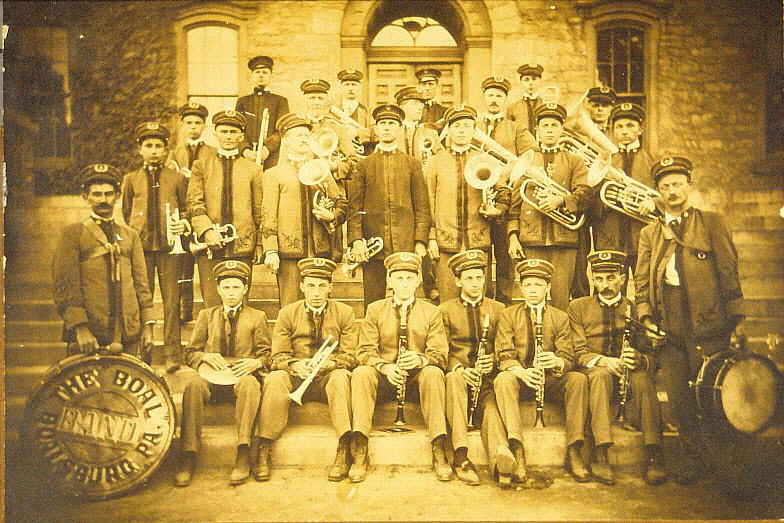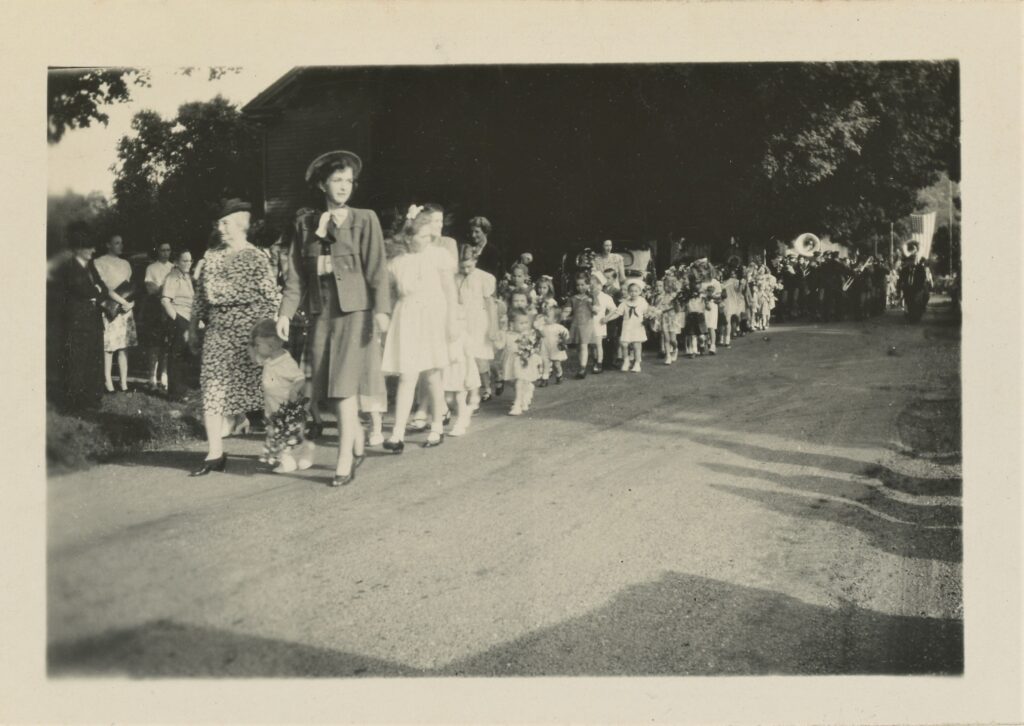Boalsburg, originally known as Springfield, is a historic village in Harris Township, near the base of Tussey Mountain.
The area was first scouted for European settlement in 1764, when General James Potter undertook his exploration of Penns Valley. Among the first owners of land was Benjamin Poultney who, in 1766, warranted property adjacent to the town that became known as Harmony Plantation. Reuben Haines later bought these warrants and sold the land for development.
After the Revolutionary War, settlers, especially German and Irish immigrants, moved to the valley. Among the settlers, was David Boal, who received a land grant in 1789 and built a stone cabin in 1803, which still stands as part today’s Boal Mansion. It is the oldest remaining building in Boalsburg. His son, David Boal Jr., settled his family on his father’s property. Later that year, David and his wife, Nancy, added a farmhouse to the property.

Springfield was a junction of several roads which meant there was a regular stream of traffic. As more people settled in the valley, mills opened in the area. Michael Jack created a grist mill in 1791 on Spring Creek one mile east of today’s diamond. In 1808, Andrew Stroup laid out a plan for an expanded village. Lots were sold at auction for $11 each.
In 1804, David Boal Jr. established the first tavern in Springfield, the Boal Tavern. At the time, much of the local economy relied on traffic from stage coaches and wagons. Travel times were long, with the trip from Philadelphia to Bellefonte taking from ten days to more than two weeks, and even longer to Spruce Creek and on to Pittsburgh.
Taverns were crucial as they gave travelers a place to lodge overnight. Boalsburg later became home to two more taverns. The Boalsburg Tavern, established in 1819, still stands today as Duffy’s Tavern. The Wolfe Tavern opened in 1834 and was a log building focused on serving cattle drivers and locals.
While many villages in the area had taverns, Springfield was the only one to offer overnight accommodation. This feature made the village a favored place to stop along the road.
A stagecoach route beginning at Lewisburg and traveling west through Penns Valley started once the population was large enough to maintain a quality road. Travelers from Harrisburg or elsewhere trying to reach Bellefonte or areas further west traveled the route, although banditry and wild animal attacks were known to occur.
The traffic was the basis for much of the early industry in the village. In 1804, William Murray moved his tannery operation to the eastern end of Springfield from Nittany Mountain. He made leather for use in the creation of goods, including shoes and saddles. Blacksmiths, as well as a carriage and wagon shop, provided repairs and replacement parts to travelers. Felix Dale opened a forge in 1823 manufacturing his well-known double-edged axes.
As the economy of Boalsburg developed, the need for a permanent post office arose. Originally, the mail was dropped off at an old pine tree on top of a hill, which was a distinctive landmark on foot paths. When the post office was established in 1820, a vote was taken and the west end of town, commonly called Boalsburg because of the dominance of the Boal estate in the area, and the rest of the village of Springfield, merged, taking the name Boalsburg after David Boal Jr.

The first church was built in 1827. The Zion Union Church, also called the Old Stone Church, was home to a Lutheran and a German Reformed congregation. It was located at the current place of the Zion Lutheran Church, built on top of the site in 1867 after the original stone structure was deemed unsafe. The original Reformed congregation built a new building next door in 1861, which is today the St. John’s United Church of Christ.
The first school in Boalsburg was a log cabin built in 1802, but as the population grew, it moved to a brick building in 1847. In 1853, the Boalsburg Academy opened as a paid academy designed to provide an education for older students.
In 1858, James Patterson become the headmaster of the academy. He played a key role in Boalsburg’s participation in the Civil War. In 1862, after President Abraham Lincoln issued a call for more volunteers, Patterson announced his intent to enlist and encouraged his male students to follow. One hundred and twenty-seven men from Boalsburg signed on for service, and they formed Company G of the 148th Pennsylvania Volunteers.
In October 1864, three women from Boalsburg — Emma Hunter, Sophie Keller, and Elizabeth Meyer — met to place flowers on the graves of Dr. Rueben Hunter, a military surgeon, and several other soldiers who had died during the war. Since that time, Boalsburg has claimed to be the birthplace of Memorial Day, although other communities in the U.S. also make the claim. In 2000, a bronze statue of the three women was placed in the cemetery behind the Zion Lutheran church to commemorate the event.
After the Civil War, the economic boom of the late 1800s largely bypassed Boalsburg. As trains increasingly connected the country, stagecoach routes fell into disuse. The nearest railroad, the Pennsylvania L&T line, hugged Mount Nittany on its way to Bellefonte, avoiding Boalsburg completely. This effectively isolated the village, and its population decreased to about 300. Many businesses closed, leaving most citizens to make their living as farmers.
With the growth of Penn State following World War II, Boalsburg increasingly became a bedroom community. That brought on a notable increase in the village’s population, from less than 1,000 before 1940 to almost 4,600 in 2020. It also added diversity among the residents, and more activity and demand for local businesses. While the days of blacksmithing and wagon repairs are gone, there are now restaurants and shops.

“Historic Boalsburg” might be said to begin with Theodore Davis Boal, the architect and great-grandson of David Boal, Jr.. “Terry” Boal lived a large part of his life in France, where he met his wife, Mathilde Denis de Lagarde, and she gave birth to their son, Pierre. When they returned to Boalsburg in 1898, Theodore renovated the mansion to match the splendor of its European counterparts.
In 1909, he paid to ship the contents of the Columbus Family Chapel to Boalsburg, which Mathilde inherited from her widowed aunt. After serving in World War I, Theodore built the 28th Division Shrine, which now stands as the Pennsylvania Military Museum. However, all these ventures proved costly, and during the Great Depression, Theodore lost the remaining Boal fortune. On his death in 1938, the mansion closed. In 1952, Pierre opened the Boal Mansion and as a museum and organized a nonprofit foundation to continue its management.
Starting in the late 1960s, a marked interest in historic preservation and conservation arose among members of the Boalsburg community. Integral in the progress of the movement was the Boalsburg Village Conservancy, established in 1973. In 1977, Boalsburg’s historic district — comprising 140 buildings — was listed on the National Register of Historic Places.
The prosperity and appeal of Boalsburg thereafter increased as the preserved Georgian- and Victoria-style houses — dating back to mid- to late-19th century construction — gained value as tourist attractions, bringing visitors for day trips. In 1982, the Boalsburg Heritage Museum opened in the 1825 Sarah Sweet House.
Every year Boalsburg celebrates Memorial Day with community activities that include a parade, arts and crafts festival, car show, and the Fire Company carnival. Thousands visit and enjoy the historic atmosphere of the town.
Eddy Becker
Sources:
Community Study, Boalsburg, Pennsylvania, 1937-1938. [State College, Pennsylvania State College, Department of Home Economics, 1938].
Evans, Susan. Hazleton, Robert. Horner, Cathy. Taylor, Nancy. 2012. Boalsburg, A War, Three Women, and a Tradition: The History of Boalsburg in the Civil War. Centre County Historical Society, 2012.
Lee, Christopher. “The Boals of Boalsburg: Two Hundred Years of a Pennsylvania Heritage.” Pennsylvania Heritage, Fall 1989.
Linn, John Blair. History of Centre and Clinton Counties. Philadelphia, 1883.
Magargel, Myrtle. “1938-1939 Conversations with Myrtle Magargel, Colonial Boalsburg” Centre Daily Times, 1939.
Randolph, Thomas. A History of Boalsburg, Pennsylvania: The Growth of an American Village. Mt. Nittany Press, 2020.
Walker, Karen. “Boalsburg Charm: History, Tradition Remain at the Heart of This Fast-Growing Community.” Town & Gown, 2019.
First Published: November 30, 2023
Last Modified: April 17, 2025
